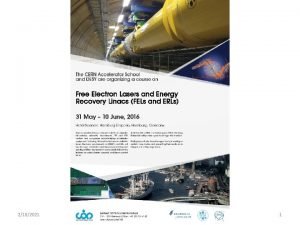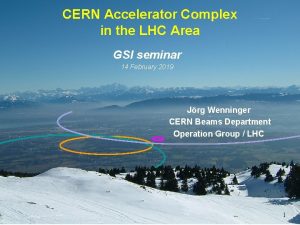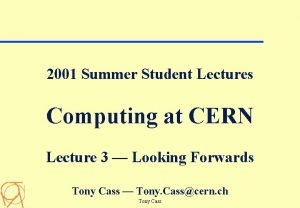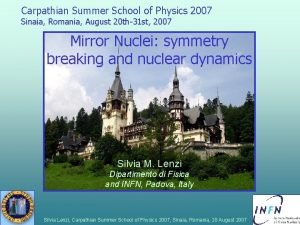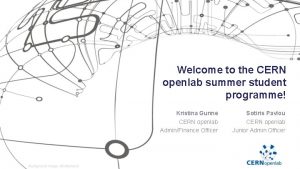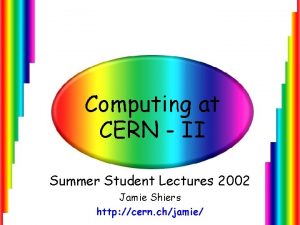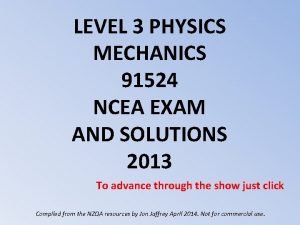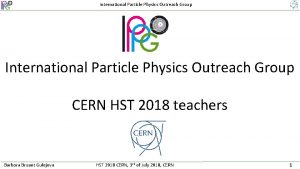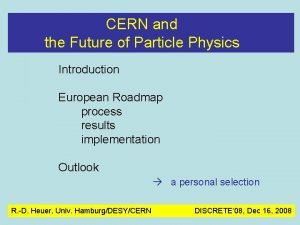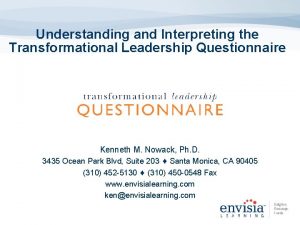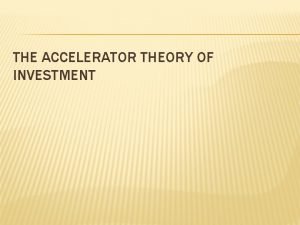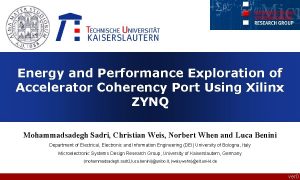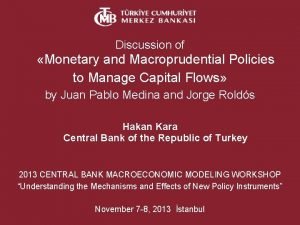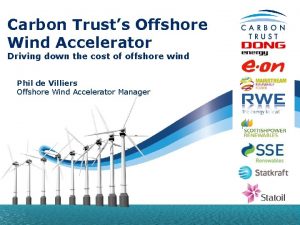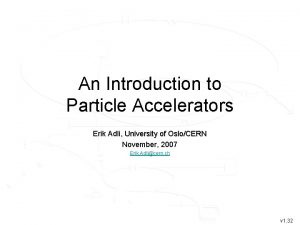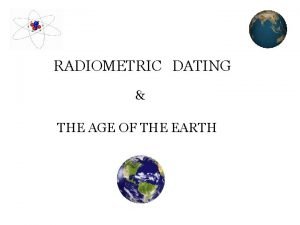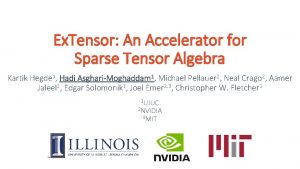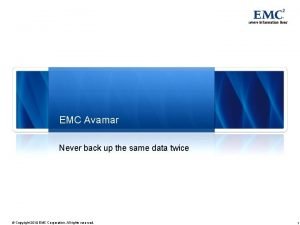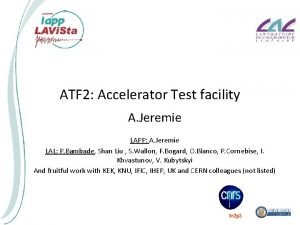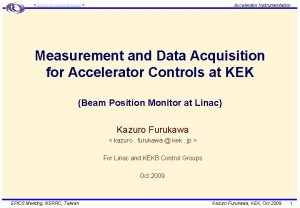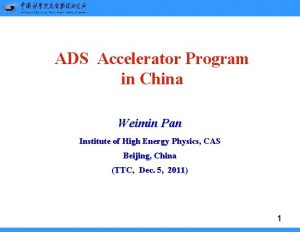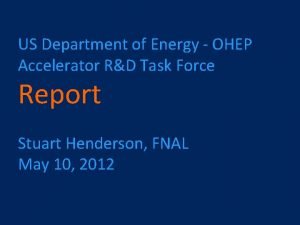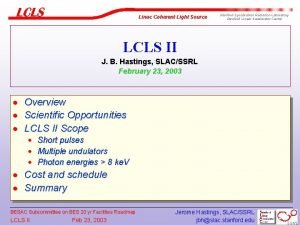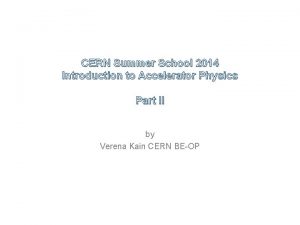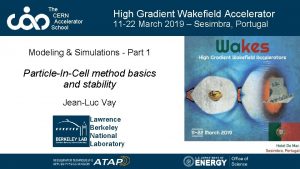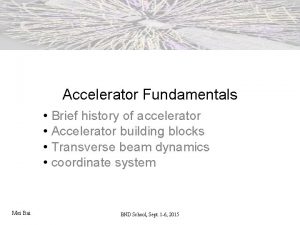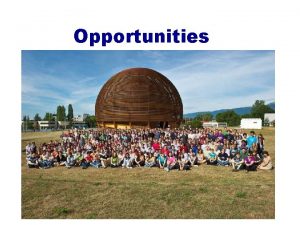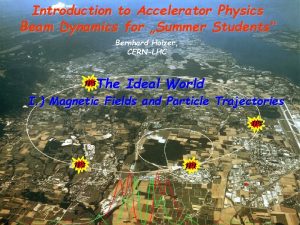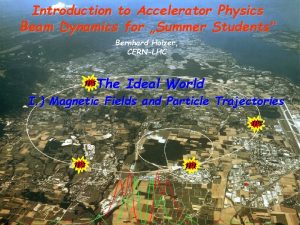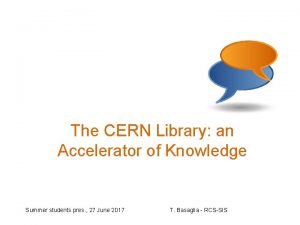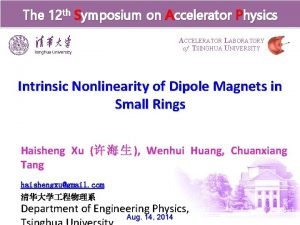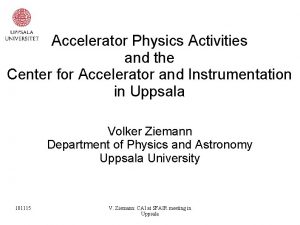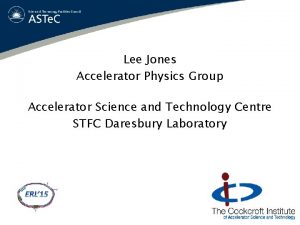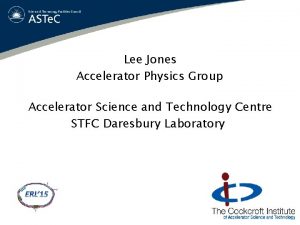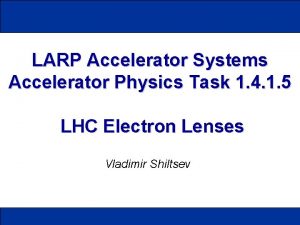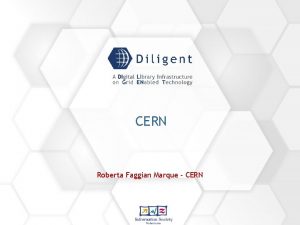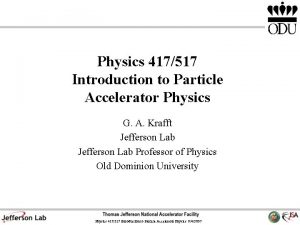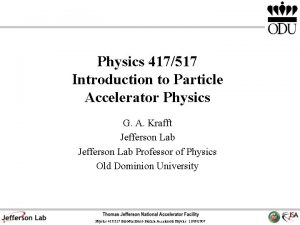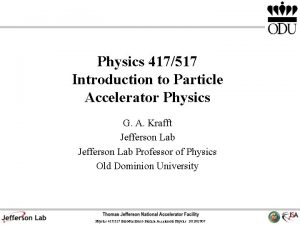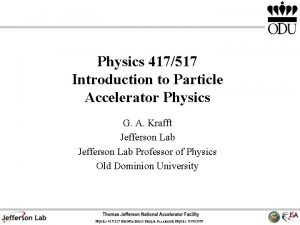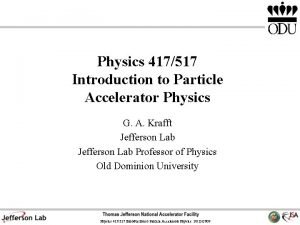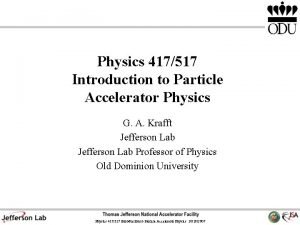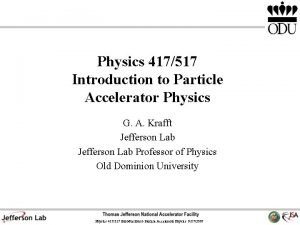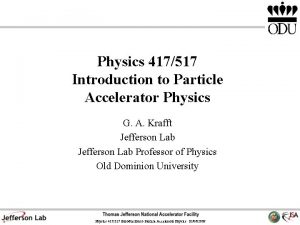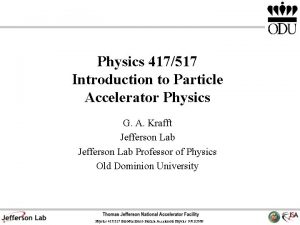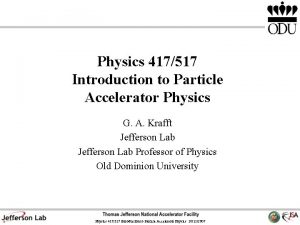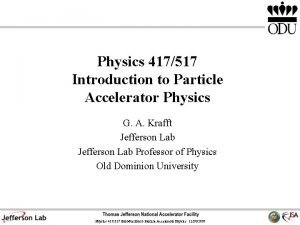CERN Summer School 2014 Introduction to Accelerator Physics










































- Slides: 42

CERN Summer School 2014 Introduction to Accelerator Physics Part I by Verena Kain CERN BE-OP

Acknowledgement These lectures are based on lectures given by Bernhard Holzer at the CAS (CERN Accelerator School) Oliver Bruning at the CAS Frank Tecker at the CAS Peter Forck at the JUAS (Joint Universities Accelerator School) Philipp Bryant at the JUAS and the textbooks: S. Y. Lee, “Accelerator Physics”, World Scientific K. Wille, “Physics of Particle Accelerators and Synchrotron Radiation Facilities”, Teubner and LHC talks by: M. Lamont J. Wenninger

Contents of these Lectures Goal: provide basic understanding of accelerator physics 5 Lectures Lecture 1: Introduction & Motivation, History Lecture 2: Transverse Dynamics Lecture 3: Longitudinal Dynamics Lecture 4: Imperfections, Measurement, Correction, Injection, Extraction Lecture 5: LHC, LHC performance and LHC Challenges

Goal of Accelerator Goal of an accelerator: increase energy of CHARGED particles • Increase energy how • The particle trajectory direction dr parallel to v • …increase of energy with electric fields • Magnetic fields are needed for control of trajectories.

Goal of Accelerator • Call them accelerator, but depending on the particle the velocity reaches maximum value often already at low energy • Velocity does not change there after, momentum (mass) does Particle rest mass: electron 0. 511 Me. V proton 938 Me. V 239 U ~220000 Me. V

The units we are using… Energy: in units of e. V: corresponds to the energy gained by charge of a single electron moved across a potential difference of one volt. 1 e. V = 1. 602176565(35) × 10 -19 × 1 J This comes from electrostatic particle accelerators. Unit of mass m: we use Unit of mass is e. V/c 2 Unit of momentum p: with Unit of momentum is e. V/c

Units from Electrostatic Accelerator The basic principles of such an electrostatic accelerator: Target Particle Source T Power supply E- Field

Goal of accelerators in particle physics 1) Provide particles with high energy 2) Provide collisions

The CERN Accelerator Complex PS (Proton Synchrotron): 1959 LHC (Large Hadron Collider): 2008 Circumference: PS ~ 628 m LHC ~ 27 km Energy: PS 26 × 109 e. V (Ge. V) LHC 7 × 1012 e. V (Te. V) Particles produced through: PS: fixed target collisions LHC: beam-beam collisions Why high energies? Why so large? Why collisions?

Why high energies? Accelerators are instrument to study smaller and smaller structures and heavy short-lived objects with Wavelength of probe radiation needs to be smaller than object to be resolved Object size Radiation energy Atom 10 -10 m 0. 00001 Ge. V Nucleus 10 -14 m 0. 01 Ge. V Nucleon 10 -15 m 0. 1 Ge. V Quarks - > 1 Ge. V

Why collisions? • Conservation laws: e. g. momentum and energy conservation e+ g Nucleus e- Photon into e+, e- only in proximity of nucleus. Nucleus takes part of momentum (and part of available energy…) • Center-of-mass Frame and Center-of-mass Energy (ECM) – Center-of-mass frame defined where: – The energy available for creation of particles corresponds to ECM

Center-of-Mass Energy Transformation to center-of-mass frame: Lorentz transformation 4 -momentum Lorentz Transformation The norm: is Lorentz invariant

ECM in Fixed Target Experiment

ECM in Collider Experiment Laboratory Frame = CM Frame Collider more energy efficient; But also more complex: two beams to be accelerated and to be brought into collision

Why do accelerators become larger and larger? This is due to technological limitations. • Magnetic field, accelerating gradient, … • Circular machine: – the higher the particle momentum, the higher the magnetic field to keep beam on trajectory – the higher bending angle (the smaller R), the higher the magnetic field

Which particle to use? e- , e + p+ Elementary particles with no internal structure Consist of quarks held together by gluons The total energy of the collider is transferred into the collision The constituents of the protons collide. The energy available for the collision less than the collider energy Precision measurements: beam energy can be exactly tuned to optimize the analysis Discovery machine: with a single chosen beam energy different processes at different energies can be scanned Disadvantage for circular colliders: low mass of these leptons. High power loss due to synchrotron radiation Solution: linear accelerators - long

HISTORY OF ACCELERATORS

Natural Accelerators • Radioactive Accelerators – Rutherford experiment 1911 – Used a particles tunneling through the Coulomb barrier of Ra and Th to investigate the inner structure of atoms – Existence of positively charged nucleus, d ~ 10 -13 m – a particle kinetic energy ~ 6 Me. V • Cosmic rays – Energies up to 3 x 1020 e. V for heavy elements have been measured. ~ 40 x 106 times what the LHC can do. – “Ultra high energy” cosmic rays are rare…

Why accelerators then…. ? Accelerators have the advantage: High energies, high fluxes of a given particle species, controlled energies at a specific location where a detector can be installed.

Electrostatic Accelerators – 1930 s • Cockcroft-Walton electrostatic accelerator – High voltage source by using high voltage rectifier units – High voltage limited due to sparking in air. Limit ~ 1 MV CERN used until 1993 as ion-source: 750 k. V

Electrostatic Accelerators Break down voltage • Limit of 1 MV overcome: placing the electrodes under high pressure gas. Paschen’s law Break down voltage depends on gas pressure and gap between electrodes. Product of pressure x gap • Van De Graaf generator – 10 MV

Tandem Van de Graaf Generator • …use the accelerating voltage twice • Up to 25 MV • Advantages of Van de Graaf: – Great variety of ion beams – Very good energy precision, small energy spread • Applications in nuclear physics, accelerator mass spectroscopy, …

Alternating RF Field – the Revolution Electrostatic accelerator limitation: maximum voltage before sparking for acceleration over single gap • pass through acceleration gap many times (Ising) • 1928 Wideroe: first working RF accelerator Energy gain per gap: E = q VRFsin(fs) Fs…phase wrt to RF field • Particle synchronous with field. In shielding tube when field has opposite sign. Voltage across each cell the same. • Remark: tubes have to become longer and longer, as particles become faster and faster or higher frequency l = c/f. RF But radiation power loss: P = w. RFCVRF 2, C gap capacitance • •

Alvarez Linac or Drift Tube Linac • Eliminate power loss: drift tube placed in cavity – Electromagnetic field oscillating in cavity. Standing wave, TM mode ( longitudinal E-Field, transverse B-Field) – Resonant frequency of cavity = accelerating field frequency – Reduce power loss – Exploit Farraday’s law:

Circular Accelerators • Linear accelerators can in principle accelerate to arbitrarily high energies. • …. but become longer and longer • Particles on circular paths to pass accelerating gap over and over again • Cyclotron proposed by E. O. Lawrence in 1929 and built by Livingston in 1931.

Cyclotron Particle Source in the middle Between the two “Dees” acceleration gap connected to RF source. w. RF = wcyclotron Vertical magnetic field to guide the particles in the horizontal plane. The radius of particle trajectory becomes larger and larger with larger energy Particles extracted with a deflector magnet or an electrode. Top View

Cyclotron Limitation • Cyclotron frequency is constant for constant mass • For relativistic particles mass is not constant • The classical cyclotron only valid for particles up to few % of speed of light – Not useful for electrons…already relativistic at 500 ke. V • Possibilities: synchrocyclotrons (change frequency (and magnetic field) with energy) or isochronous cyclotrons (increase magnetic field with r, frequency constant) • Modern cyclotrons can reach > 500 Me. V (PSI, TRIUMF, RIKEN)

Biggest Cyclotron in the world • RIKEN, Japan • 19 m diameter, 8 m high • 6 superconducting sector magnets, 3. 8 T • Heavy ion acceleration • Uranium ions accelerated up to 345 Me. V/u K. Yamda et al. , “Status of the Superconducting Ring Cyclotron at RIKEN RI Beam Factory, EPAC 2008

PSI cyclotron High intensity Pmax = 1300 k. W

Betatron - 1940 • Another early circular accelerator • Idea by Wideroe in 1923. Kerst builds the first working betatron in 1940. • Difference: constant radius and magnetic field changing with time to keep radius constant. • Accelerating E-field generated through induction, no external E-field • e- accelerated to 2. 3 Me. V • “Betatron” for beta rays (e-)

Betatron – a few formulae Induction, Farraday’s law for d. E/d. Q=0 The force on the particle At the same time the magnetic field needs to compensate the centrifugal force Stability criterion

Synchrotron • Higher and higher energies – larger and larger radii, limited B fields – cannot stay compact • Fix trajectory R = constant; R can be large • Dipole magnets with field only where the beam is – “small” magnets • R= constant B field increases synchronously with beam energy • Synchrotron - all big modern machines are synchrotrons

Cosmotron – BNL – 1952 – 3 Ge. V p+ synchrotron Particles do many 1000 turns – trajectories have an angular spread divergence Need focusing elements. Cosmotron weak focusing machine

Strong Focusing Idea by E. Courant, M. Livingston, H. Snyder in 1952 and earlier by Christofilos Alternating gradient focusing – Analogous to geometrical optics: a series of alternating focusing and defocusing lenses will focus. f 1 f 2 Consider f 1=f, f 2 = - f F = d/f 2 > 0 In our case the lenses will be magnets with alternating gradients

The first alternating gradient synchrotrons Alternating gradient focusing was quickly adopted by synchrotrons and transfer lines. - 1954: Cornell University, e- accelerated to 1. 5 Ge. V (Wilson et al. ) The following two machines are still in operation. They use combined function magnets. - 1959: CERN Proton Synchrotron (PS) accelerated protons to 28 Ge. V - 1960: Brookhaven Alternating Gradient Synchrotron (AGS) accelerated protons to 33 Ge. V

The next step: storage ring colliders Make use of all the particles’ energy. 2 -beam synchrotrons. The first one: Ada (Frascatti), 1961 -64, e+, e-, 250 Me. V, 3 m circumference Many examples to come at DESY, SLAC, KEK, Fermilab with the Tevatron (980 Ge. V), BNL with RHIC 1971 -1984: ISR (CERN), p+, 31. 5 Ge. V, 948 m circumference 1981 -1984: SPS running p+, p-, 270 – 315 Ge. V, 6. 9 km circumference; discovery of W and Z Bosons 1989 -2000: LEP highest energy electron synchrotron, e+, e-, 104 Ge. V, 27 km circumference; three generations of quarks and gluons 2008 - : LHC highest energy proton synchrotron, p+, heavy ions, 4 Te. V (2. 76 Te. V per nucleon for 208 Pb 82+); Discovery of Higgs

More tomorrow…

EXTRA SLIDES

Electron source • Electrons: thermionic cathode: – Free electrons through heat. Heating with a filament to induce thermionic emission. Cathodes special metal layers with low work function to emit e- easily.

Positive Ion Sources • The principle: Plasma, electron bombardement, … • H 2 + e- → H 2+ + 2 e • H 2+ + e- → H+ + H + e • H + e- → H+ + 2 e- • H 2 → 2 H+ + 2 e- • CERN for LHC protons: Duoplasmatron – Higher density plasma at anode. density plasmas hence the name. source Two

The first cyclotron • 30 cm across • 0. 5 T magnetic field • p+ accelerated to 1. 2 Me. V

Weak Focusing Particles with deviations from the design trajectory need to feel restoring forces otherwise the beam diverges. For example for deviations in the vertical plane Need either horizontal field component… …or a radially decreasing guide field Similar considerations for horizontal plane Pole shape in combined function magnet
 Cern accelerator school 2021
Cern accelerator school 2021 Cern accelerator complex
Cern accelerator complex Cern summer school
Cern summer school Cern summer school lectures
Cern summer school lectures Carpathian summer school of physics
Carpathian summer school of physics Summer camp 2014
Summer camp 2014 Cern openlab summer student programme
Cern openlab summer student programme Cern summer student lectures
Cern summer student lectures Lodi unified summer school
Lodi unified summer school Crescenta valley high school summer school
Crescenta valley high school summer school Assignment in spanish
Assignment in spanish Nzqa mechanics level 2
Nzqa mechanics level 2 Cern particle physics
Cern particle physics Cern particle physics
Cern particle physics Transformational leadership inventory
Transformational leadership inventory Limitations of accelerator theory of investment
Limitations of accelerator theory of investment Swift biz
Swift biz Accelerator forced rescan
Accelerator forced rescan Ib economics fiscal policy
Ib economics fiscal policy Accelerator coherency port
Accelerator coherency port Financial accelerator
Financial accelerator Offshore wind accelerator
Offshore wind accelerator Erik adli
Erik adli Netbackup vmware backup process flow
Netbackup vmware backup process flow Accelerator mass spectrometry
Accelerator mass spectrometry Open capi
Open capi Extensor: an accelerator for sparse tensor algebra
Extensor: an accelerator for sparse tensor algebra Avamar ndmp accelerator
Avamar ndmp accelerator Charter network accelerator
Charter network accelerator Accelerator
Accelerator Accelerator
Accelerator Microsoft virtual machine converter solution accelerator
Microsoft virtual machine converter solution accelerator United way social innovation accelerator
United way social innovation accelerator Uplogix distibutor
Uplogix distibutor Growth accelerator coach
Growth accelerator coach Ads accelerator
Ads accelerator Medical particle accelerator
Medical particle accelerator Pharmaceutical cpq
Pharmaceutical cpq Accelerator for r&d
Accelerator for r&d Talent accelerator program
Talent accelerator program Stanford linear accelerator tours
Stanford linear accelerator tours Tca accelerator drops directions
Tca accelerator drops directions Linear accelerator stanford
Linear accelerator stanford
